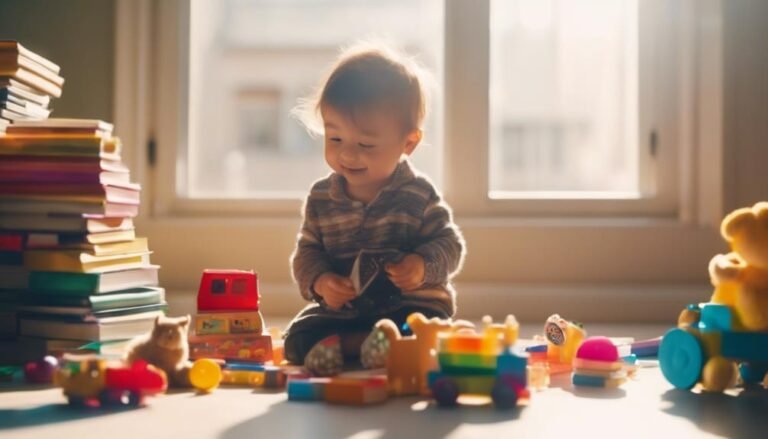Overtired Baby Sleep Tricks
Are you exhausted from trying to put your overtired baby to sleep? Don’t worry, we’ve got you covered! In this guide, we will explore some effective sleep tricks specifically designed to help your little one catch those much-needed Z’s.
Recognizing the signs of overtiredness is key to understanding your baby’s sleep needs. By setting a consistent bedtime routine, creating a sleep-friendly environment, and using soothing techniques like gentle rocking or swaying motions, you can help your baby relax and drift off to dreamland.
Remember, establishing a soothing bedtime ritual and ensuring your baby’s comfort during sleep are essential for a good night’s rest. And if you need additional support, don’t hesitate to seek professional help. Together, we’ll conquer those sleepless nights!
Key Takeaways
- Recognize the signs of overtiredness in babies, such as rubbing eyes, frequent yawning, fussiness, and pulling at ears.
- Establish a bedtime routine that includes a warm bath, gentle massage, lullabies, and reading a bedtime story.
- Create a sleep-friendly environment by following safe sleep guidelines, choosing a safe crib or bassinet, maintaining a comfortable room temperature, and using blackout curtains and a white noise machine.
- Use gentle rocking or swaying motions, babywearing, swinging or bouncing, and vibrating bassinets or cribs as alternative soothing methods to help babies relax and settle down for sleep.
Recognizing Signs of Overtiredness
You can recognize signs of overtiredness in your baby by observing their behavior and physical cues. When your baby starts to rub their eyes, yawn frequently, or become fussy and irritable, these are clear indications that they’re tired and in need of sleep. Other tired cues to look out for include yawning, pulling at their ears, and arching their back. It’s important to pay attention to these cues and act promptly to prevent your baby from becoming overtired.
Preventing overtiredness is crucial for your baby’s well-being and overall sleep quality. By establishing a consistent sleep schedule and routine, you can help regulate your baby’s sleep patterns and prevent them from becoming overly tired. Make sure your baby is getting sufficient naps throughout the day, as overtiredness can make it more challenging for them to fall asleep and stay asleep at night. Creating a calm and soothing environment for sleep, such as dimming the lights and playing soft lullabies, can also help your baby relax and transition into sleep more easily.
In addition to recognizing tired cues and establishing a sleep routine, it’s important to be responsive to your baby’s needs. Providing comfort and reassurance when they’re tired can help them feel more secure and relaxed, promoting better sleep. Responding promptly to their tired cues and offering them a soothing environment will go a long way in preventing overtiredness and ensuring your baby gets the rest they need.
Setting a Consistent Bedtime Routine
Establishing a consistent bedtime routine is essential for helping your overtired baby get the rest they need. Babies thrive on routine and predictability, and a consistent sleep schedule can significantly improve their sleep quality and overall well-being. By incorporating relaxation techniques into your baby’s bedtime routine, you can create a soothing environment that promotes relaxation and prepares them for a restful night’s sleep.
One effective way to establish a consistent sleep schedule is by creating a bedtime routine that follows a set pattern every night. This routine can include activities such as a warm bath, gentle massage, lullabies, and reading a bedtime story. By following the same sequence of events each night, your baby will start associating these activities with sleep, making it easier for them to wind down and fall asleep.
To help your baby relax before bedtime, consider incorporating relaxation techniques such as deep breathing exercises or gentle rocking. These techniques can help calm their nervous system and signal to their body that it’s time to sleep. Additionally, creating a calm and peaceful sleep environment by dimming the lights, playing soft music, and using a white noise machine can further enhance relaxation.
Creating a Sleep-Friendly Environment
To create a sleep-friendly environment for your overtired baby, focus on creating a soothing and calming atmosphere in their bedroom.
Following the ‘safe sleep’ guidelines for babies is crucial to ensure their safety and promote better sleep. Start by choosing a crib or bassinet that meets the safety standards, with a firm mattress and a fitted sheet. Remove any loose bedding, toys, or pillows that could pose a suffocation risk.
Keep the room temperature between 68-72 degrees Fahrenheit and use blackout curtains to block out any light that may disrupt your baby’s sleep. Consider using a white noise machine to drown out any sudden noises that may startle your baby awake. Soft, dim lighting can also help create a relaxing ambiance.
Keep the room clutter-free and organized, with a designated space for all baby essentials. Lastly, consider using essential oils like lavender, known for its calming properties, to create a soothing scent in the room.
Using White Noise to Soothe Your Baby
Create a peaceful environment for your overtired baby by incorporating white noise to help soothe them to sleep. White noise machines offer various benefits when it comes to helping babies fall asleep and stay asleep. These machines emit a consistent sound that mimics the soothing environment of the womb, providing a sense of familiarity and comfort to your little one.
There are different types of white noise that you can use to aid your baby’s sleep. Some popular options include ocean sounds, rainfall, and gentle lullabies. Experiment with different sounds to find the one that works best for your baby. Some babies may prefer a more rhythmic sound, while others may find comfort in a constant hum.
When using white noise to soothe your baby, it’s important to ensure that the volume is set at a safe level. Be mindful of not making it too loud, as excessive noise can be detrimental to their hearing. Additionally, try to position the white noise machine at a safe distance from your baby’s crib to prevent any potential hazards.
Incorporating white noise into your baby’s sleep routine can help create a calming atmosphere and promote better sleep. By providing the soothing sounds that mimic the womb, you can help your overtired baby relax and drift off into a peaceful slumber.
Implementing Gentle Rocking or Swaying Motions
Gently rock or sway your overtired baby to help them fall asleep more easily. The motion of rocking or swaying has been proven to have numerous benefits for babies, especially when they’re overtired. Here are some reasons why gentle rocking can be beneficial:
-
Calming effect: The rhythmic motion of rocking or swaying can have a soothing effect on your baby, helping them to relax and unwind. This can be particularly helpful when they’re overstimulated or struggling to settle down.
-
Mimicking the womb: Babies are used to the gentle movements they experienced in the womb. Rocking or swaying can help recreate that familiar sensation, providing a sense of comfort and security.
-
Promoting sleep: The repetitive motion of rocking or swaying can help lull your baby into a peaceful slumber. It can stimulate the release of sleep-inducing hormones, making it easier for them to fall asleep and stay asleep.
While gentle rocking can be an effective sleep technique, it’s important to remember that it’s not the only option. Here are some alternatives to consider:
-
Babywearing: Carrying your baby in a sling or baby carrier can provide a similar soothing effect as rocking. The close physical contact and gentle movements can help them feel safe and secure.
-
Swinging or bouncing: Some babies respond well to being gently swung or bounced in your arms or a baby swing. Experiment with different motions to see what works best for your little one.
-
Vibrating bassinet or crib: Some baby furniture comes with built-in vibration settings. These gentle vibrations can provide a calming sensation for your baby, helping them to relax and fall asleep.
Trying Different Calming Techniques
Continue to explore different calming techniques to help ease your overtired baby’s transition into sleep. While gentle rocking or swaying motions can be effective, it’s important to also consider alternative soothing methods and natural sleep aids. Every baby is different, so what works for one may not work for another.
One technique to try is white noise. The consistent sound helps drown out background noise and can create a soothing environment for your baby. You can use a white noise machine or even a simple fan or humidifier. Experiment with different sounds to find what works best for your little one.
Another option is massage. Gentle, rhythmic strokes can relax your baby’s muscles and promote a sense of calm. You can use baby-safe oils or lotions to make the massage more soothing. Be sure to use gentle pressure and pay attention to your baby’s cues to ensure they’re enjoying the experience.
Aromatherapy is another natural sleep aid to consider. Lavender, chamomile, and vanilla are known for their calming properties. You can use essential oils in a diffuser or mix a few drops with a carrier oil and apply it to your baby’s skin. Remember to always dilute essential oils and consult a professional before use.
Establishing a Soothing Bedtime Ritual
To ensure a peaceful transition into sleep for your overtired baby, it’s important to establish a soothing bedtime ritual. Creating a peaceful atmosphere and incorporating relaxation techniques can help your little one unwind and prepare for a restful night’s sleep.
Here are some practical tips to help you establish a bedtime routine that will calm and comfort your baby:
-
Dim the lights: Lowering the lights in your baby’s room signals to their brain that it’s time to wind down. Use soft, warm lighting to create a cozy and relaxing environment.
-
Gentle massage: A gentle massage before bedtime can work wonders in soothing your baby. Use gentle strokes and a calming lotion to relax their muscles and promote relaxation.
-
Soft music or white noise: Playing soft, soothing music or white noise can create a calming atmosphere and drown out any distracting noises. Choose gentle melodies or nature sounds that will help lull your baby to sleep.
Ensuring Your Baby’s Comfort During Sleep
To ensure your baby’s comfort during sleep, prioritize creating a safe and cozy sleeping environment. Ensuring sleep safety is crucial to promoting healthy sleep habits for your little one.
Start by placing your baby on their back to sleep, as this reduces the risk of sudden infant death syndrome (SIDS). Use a firm and flat mattress that fits snugly into the crib to prevent suffocation hazards.
Avoid placing any pillows, blankets, or stuffed animals in the crib, as they can pose a suffocation risk. Instead, dress your baby in a sleep sack or a wearable blanket to keep them warm. Maintain a comfortable room temperature, around 68-72 degrees Fahrenheit, to prevent overheating.
Consider using a white noise machine to create a soothing and calming environment for your baby. It’s also important to check the crib regularly for any loose or broken parts to ensure your baby’s safety.
Seeking Professional Help if Needed
Consider consulting a pediatric sleep specialist if you’re struggling to address your overtired baby’s sleep issues. Seeking professional help can provide you with the expertise and guidance needed to improve your baby’s sleep and your overall well-being.
Here are a few reasons why professional advice from sleep consultants can be beneficial:
-
Specialized knowledge: Pediatric sleep specialists have extensive training and experience in understanding and addressing sleep problems in infants and young children. They can provide you with personalized strategies and recommendations based on your baby’s unique needs.
-
Comprehensive assessment: Sleep consultants can conduct a thorough evaluation of your baby’s sleep patterns, environment, and overall health. This assessment can help identify any underlying factors contributing to your baby’s sleep difficulties, such as medical conditions or developmental issues.
-
Tailored sleep plans: Based on their assessment, sleep consultants can develop a customized sleep plan that takes into account your baby’s age, temperament, and individual needs. These plans often include strategies for establishing healthy sleep habits, managing sleep associations, and promoting longer and more restful sleep.
Frequently Asked Questions
How Long Should I Use White Noise to Soothe My Overtired Baby?
To transition from white noise to other sleep aids for your overtired baby, start by gradually reducing the volume over time. While white noise can be soothing, using it for too long may impact your baby’s sleep development.
What Are Some Different Calming Techniques I Can Try to Help My Baby Sleep?
To help your baby sleep, try different sleep training methods and create a sleep friendly environment. Calming techniques like swaddling, gentle rocking, and white noise can be effective. Trust your instincts and find what works best for your little one.
How Can I Establish a Soothing Bedtime Ritual for My Baby?
To establish a soothing bedtime ritual for your baby, consistency is key. Create a calming routine that includes activities like a warm bath, gentle massage, and reading a bedtime story. By following this routine every night, your baby will associate it with sleep and feel comforted.
What Are Some Signs That My Baby Is Not Comfortable During Sleep?
Are you wondering if your baby is uncomfortable during sleep? Look out for signs like restlessness, frequent waking, and crying. Common sleep disruptions in babies include teething, hunger, and wet diapers.
When Should I Consider Seeking Professional Help for My Baby’s Sleep Issues?
If your baby’s sleep issues persist despite your best efforts, it may be time to seek professional help. Consider seeking therapy or exploring sleep consultant options to find tailored solutions for your little one’s sleep troubles.
Conclusion
In conclusion, by recognizing signs of overtiredness in your baby and implementing the sleep tricks mentioned, you can help create a peaceful and restful environment for your little one.
Just like a gentle lullaby that lulls your baby into a peaceful slumber, these tips can guide you towards achieving a harmonious bedtime routine.
Soothing your baby to sleep is like a calming breeze that brings tranquility to your home.
Rest assured, with these practical techniques, your baby will be on their way to a good night’s sleep.








